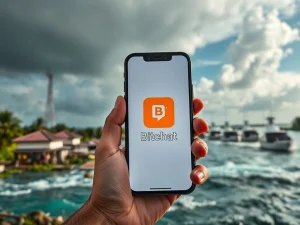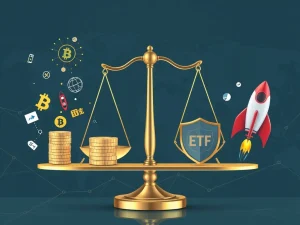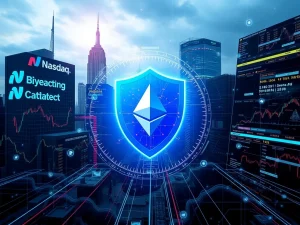Unbelievable Fartcoin Surge: How Troller Cat Aims for Monumental Presale ROI

The cryptocurrency world is no stranger to unexpected phenomena, and the recent astronomical rise of Fartcoin stands as a testament to the power of viral appeal in the digital asset space. While this toilet humor-themed token captured headlines with an astounding 2.6 million percent surge, another intriguing project, Troller Cat ($TCAT), is quietly building momentum, promising substantial returns through a more structured approach. This article dives into the contrasting journeys of these two meme-inspired cryptocurrencies, exploring what drives their value and what investors should consider.
Fartcoin’s Explosive Crypto Surge: More Than Just a Joke?
In a truly remarkable display of market volatility and meme power, Fartcoin has seen its value skyrocket by an incredible 2,687,514.33% over the past year. What began as a token priced at a minuscule $0.000004723 in October 2024, ballooned to a market value of $1.34 by early 2025. Despite a recent 12.22% dip and a current market capitalization of $1.34 billion, its 30-day gain of 32.7% underscores its viral attraction. This phenomenal crypto surge, however, raises questions about sustainability.
- Community-Driven Value: Fartcoin’s success is deeply intertwined with community engagement and meme culture, relying heavily on influencer-driven hype and brand partnerships.
- Lack of Tangible Utility: Unlike many emerging cryptocurrencies, Fartcoin currently lacks fundamental utility such as staking mechanisms or deflationary protocols. Its value is rooted almost entirely in cultural virality.
- Speculative Future: While some analysts project Fartcoin could challenge its all-time high (ATH) of $2.61 by Q1 2026, the absence of GameFi infrastructure or staking options limits its long-term viability and makes its future highly speculative.
Troller Cat: A Strategic Meme Coin with Projected Presale ROI
While Fartcoin rides the wave of pure virality, Troller Cat ($TCAT) is positioning itself as a more structurally innovative meme coin. Currently in Stage 14 of its 26-stage presale, $TCAT has garnered significant attention with a projected 449.19% return on investment (ROI) from its current price of $0.00009667. Since its launch at $0.00000500, $TCAT has already surged by 1833.40%.
- Structured Presale: The project’s 26-stage presale model offers clear price increases, with the next stage slated to increase by 9.96%.
- Robust Foundations: Troller Cat has already raised $400,000 and attracted over 1,500 holders, supported by a fully audited smart contract, 2-year liquidity locks, and attractive 69% annual percentage yield (APY) staking rewards.
- Utility and Roadmap: Unlike Fartcoin, Troller Cat boasts a clear roadmap that includes a deflationary Game Center and a referral program offering 10% bonuses for both referrer and referee. This focus on utility aims to provide long-term value beyond mere hype.
- Transparency and Security: The project emphasizes transparency with 1% team allocation locked for 69 weeks and transparent KYC verification, building investor confidence.
Navigating the Meme Coin Landscape: Virality vs. Strategic Presale ROI
The contrasting approaches of Fartcoin and Troller Cat highlight the diverse strategies within the meme coin sector. Fartcoin’s success is a prime example of how cultural momentum can drive unprecedented gains, albeit with inherent risks due to its lack of utility. Its $311.37 million 24-hour trading volume reflects mainstream appeal, yet sustainability concerns persist.
Conversely, Troller Cat, though less established, offers a structured ecosystem designed for actionable returns. Its 26-stage presale, inspired by historical trolls like Diogenes and Doge, blends entertainment with a clear presale ROI strategy. A $5,000 investment at Stage 14 could potentially grow significantly if the token reaches its listed price of $0.0005309.
Investors are presented with a choice: embrace Fartcoin’s high-risk, high-reward cultural momentum, or consider Troller Cat’s layered approach, which combines ROI projections with utility and security features. As Stage 14 progresses for $TCAT, its performance could signal a broader shift in how investors evaluate the long-term potential of meme projects.
The cryptocurrency market continues to evolve, with meme coins carving out a unique niche. While Fartcoin’s incredible 2.6 million percent rise proves that cultural virality can scale rapidly, Troller Cat’s strategic design, emphasizing utility, security, and clear ROI projections, offers a compelling alternative. This dichotomy underscores the diverse investment opportunities and inherent risks present in the dynamic world of digital assets. Ultimately, the decision rests on an investor’s appetite for risk versus their desire for a project with a more defined roadmap and potential for sustainable growth.
Frequently Asked Questions (FAQs)
Q1: What is the primary difference between Fartcoin and Troller Cat?
A1: Fartcoin’s value is primarily driven by cultural virality and meme appeal, lacking tangible utility. Troller Cat, on the other hand, emphasizes structural innovation, offering features like staking, a deflationary Game Center, and a clear presale roadmap.
Q2: How much has Fartcoin surged over the past year?
A2: Fartcoin has surged by an astounding 2,687,514.33% over the past year, transforming from a fraction of a cent to a market value of $1.34.
Q3: What is the projected ROI for Troller Cat’s current presale stage?
A3: Troller Cat ($TCAT) in Stage 14 of its presale has a projected return on investment (ROI) of 449.19% from its current price.
Q4: Does Troller Cat offer any utility or staking rewards?
A4: Yes, Troller Cat offers 69% annual percentage yield (APY) staking rewards. Its roadmap also includes a deflationary Game Center and a referral program, indicating a focus on utility.
Q5: What are the main concerns regarding Fartcoin’s long-term viability?
A5: Analysts express concerns about Fartcoin’s long-term viability due to its absence of staking or GameFi infrastructure, relying almost solely on influencer-driven hype and brand partnerships without a clear utility roadmap.









